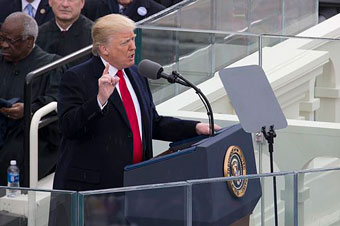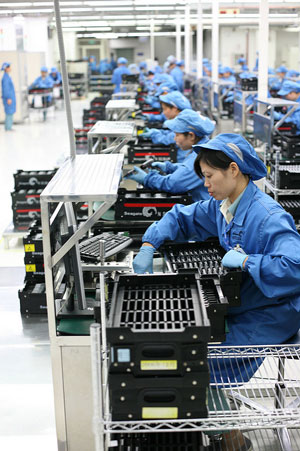Dancing with China
China is not an obstacle to American leadership
On the same day that Britain decided to assert its insularity by leaving the European Union (EU), the board meeting of the Asian Infrastructure Investment Bank (AIIB) was held in Beijing. Britain was represented there, but the United States was a critical outsider at the much quieter event on the other side of the world.
The governments of two-thirds of the world’s population signed up for the AIIB, including a good mix of developing and advanced economies, as well as many American allies. Countries as diverse as Israel and Iran, Germany and India, were there. We were not, and we tried unsuccessfully to persuade our friends not to join. That was a mistake. If we had been involved with the AIIB from the beginning, it would be a better institution and we would be better positioned for continued leadership in Asia.

In his inaugural address, President Trump did not mention China, but his sweeping criticism of previous American administrations implies that China will be a primary target for major changes in trade and investment policy. It is also possible that the new administration will confront China more aggressively regarding Taiwan and its maritime sovereignty claims. However, China policy cannot be reduced to a single issue area, such as standing tall in the South China Sea. The other claimants to the disputed islands there are all founding members of the AIIB, and China is their largest trading partner. It is also the largest trading partner of the EU. China is our largest source of imports and our third-largest export market, after Canada and Mexico.
Making America great again requires global leadership, and leadership is interactive.
As Trump said, every country puts its interests first. However, the problem with an isolationist interpretation of “America First” is that America is not isolated. Global withdrawal means cutting the bonds of mutual interest. From its beginnings, the U.S. has been a commercial nation, and it has been the political and economic center of the global order for the last 70 years. Making America great again requires global leadership, and leadership is interactive. China is not an obstacle to American leadership, but China policy is its greatest challenge.
Leading the dance
Dancing with China is not easy, and maintaining the lead is still more challenging. While stepping on China’s toes may be satisfying for a moment, it sets up a chain reaction of moves and countermoves whose only reliable product is crisis. Soon enough Trump will be immersed in high-adrenaline crisis management around the world. Here are some strategic principles for crisis prevention with China:
Good diplomacy should always emphasize the positive big picture, but in the case of China it is particularly important.
- Show balanced respect In economics, politics, and security, the United States is and will remain the leading global power. For this reason, it is important to show respect for others. Unless they are respected, their deference appears to their domestic audiences to be an unacceptable capitulation. China is often rightly criticized for having a “victim mentality,” but it is hard not to remember the humiliations of the past when one is confronted by the innuendos of a superior attitude. However, both countries rightly rejected the idea of “G-2,” a U.S.-China condominium. Respect for China must be balanced by respect for Japan, India, Southeast Asia, and other neighbors.
- Emphasize the positive and the long range Squeaky wheels get attention, but the wagon is what counts. Good diplomacy should always emphasize the positive big picture, but in the case of China it is particularly important. We have entered an era in which China is our most important bilateral relationship, and it is one with ramifications for all of our other relationships as well. China is the “big” in “big picture,” and it will be there for a long time.
- Design to include If we are simply defending the status quo and China is moving ahead, in the dance we will appear to be on the back foot. However, inclusive design is important. Remember that the Marshall Plan initially invited the Soviet Union and Eastern European countries to participate, and it was their decision not to join. An area in which we are already in the lead and should take a step forward is in cooperative space programs.
- Pick confrontations carefully, and trim to size Our relationship with China is multifaceted and we have different interests and perceptions. Therefore, confrontations are inevitable. As the stronger side, it is tempting to wave the big stick in every confrontation. However, smart power trims the sanction or threat to fit the matter at hand, and it does not bluff. It also soberly estimates what its power can accomplish and what it might cost to commit. President Truman’s Berlin Airlift in 1948–49 was an excellent example of a successful confrontation. However, the airlift was possible—and the transport capacity was available—because General Marshall had earlier recommended against deploying American troops to support Chiang Kai-shek’s losing effort in the Chinese civil war. Marshall did not support the Communists, but he was realistic enough to realize that we could not turn the tide. He was criticized for “losing China,” but in reality he helped save Berlin.
- Negotiate the lose-lose situations There will be many situations in which competition does not lead to one side winning, but rather to both sides losing. This happens in economic interactions, but it is most obvious in security. No one wins in cyberwar; it is too easy to do damage and too difficult to prevent. If both sides are vulnerable (and the rest of the world as well), then a stalemate situation exists in which a protocol of mutual restraint is the only rational solution. Similar situations exist in space weaponization and in naval activities in China’s coastal waters. If neither side can win, they have a common interest in reducing risk. We must get beyond the mentality that the only security lies in invulnerability. Invulnerability is fragile and very expensive.
The bottom line is that we have to live with China. The good news is that the relationship has done us both good in the past, and it can continue to do so in the future.

The dragon in the room
China’s sudden rise has evoked alarm and even panic, especially since American and global confidence was shaken by the financial crisis of 2008. China appeared to sail through the crisis with 10 percent growth and bags of investment dollars. Things look different after the collapse of its stock market in 2015 and greater attention to its problems of debt and industrial overcapacity. Nevertheless, growth is likely to continue in the 5–6 percent range as it did in 2016, and its service sector and domestic market are growing. What China calls its “new normal” will have its ups and downs, but crashing is unlikely, and a return to skyrocketing even less so.
China is big, not rich.
But China has already risen. By one World Bank measure it is already the world’s largest economy. The United States and China together are one-third of the world economy, and each is larger than the next three economies put together. But China is big, not rich. Its national wealth is only a quarter of ours, and with four times the population its per capita production is one-quarter that of an advanced economy like Germany or the U.S. Ironically, China’s prospects are bright because it is behind the U.S. rather than ahead—while we are already urbanized and must push the technological envelope, China’s population is still moving to the cities and it can buy, borrow, or steal advanced technology. But its growth rate will slow as higher wages, pollution, and a rapidly aging population take their toll. Over time, our anxieties about China’s rise—and its own illusions of grandeur—will fade. But China will still be there, and it will still be big.
If China is as big as we are but not as wealthy, and just as involved in the global economy but at a different level of product, then we will each be the other’s major concern. Even without crises or hostility, we will be more exposed in this bilateral relationship than in any other. The asymmetry in technology gives us a huge advantage in military affairs, but China is quite capable of pushback, and it can defend itself. Yet a new cold war is unnecessary and unlikely. The rest of the world now needs us both, for different reasons, so why would they want to join hostile camps? We are the two main pillars of the world economy; for one pillar to knock out the other would be destructive for all.
A dance, not a race
The United States is not a falling power, but China is definitely a rising one. There have been many cases throughout history in which the crossed paths of rising and falling powers have led to wars—so many, in fact, that the phenomenon has been named the “Thucydides Trap,” after its first observer. A classic case is Britain, Germany, and the First World War. But the situation of the United States and China is different in three fundamental respects.
First, their situations are asymmetric. China will not catch up to us in wealth or technological sophistication. China is a hard-working producer of large-scale goods that are particularly attractive at the consumer level. Moreover, China’s crowded Asian neighborhood is its chief challenge and opportunity. We are a two-ocean global economy driven by services and innovation. Our further development does not threaten China; China’s further development will not overtake us. We are both moving forward, but we are not running on the same track.

Second, our current relationship with China will last a long time. It is not a sprint, it is an era. Of course, the future only looks smooth because it hasn’t happened yet, but it would take quite a cataclysm to make China small or the United States poor. There is a 22-year gap between estimates of when the Chinese economy will be as big as ours, but the gap is due to what is measured, not to fluctuation. If we look at the market basket of goods produced, China is already bigger. If, however, we look at the global value of production, we are ahead into the 2030s, and by that time China will be getting older and marching more slowly. In any case, China is not likely to catch up in per capita wealth or productivity in this century. So for at least a generation we will be the biggest economies, but different. Neither will be able to do what the other is doing.
Third, China is not alone. China attracts attention because of its size and its recent fast growth, but it is part of a larger phenomenon of middle-income countries growing faster than higher-income countries. In the 20 years from 1994 to 2014, the share of low- and middle-income countries in global production rose from one-third to one-half. The trend is likely to continue, and other middle-income countries like India and Vietnam may well grow faster than China. Thus the rank ordering of the world’s largest economies is likely be quite different in 2050: China, India, United States, Indonesia, and Brazil, according to PricewaterhouseCoopers, while the five wealthiest major countries will be from among the usual suspects: United States, Australia, Germany, South Korea, and Canada. Wealth still matters, but the world is no longer “the West and the rest.”
Asia turns with China
When President Obama began his pivot toward Asia in 2009, China was part of the picture. But as time went on and tensions developed, we concentrated on our traditional allies. China’s neighbors were also concerned about its growth and its assertiveness, and so we were welcomed back as a balancing global power.
Our friends in Asia do not want to choose between us and China.
It is certainly a good idea to be engaged in Asia. In a world of rather sober growth prospects, it is the biggest bright spot. However, as the near-universal membership in the AIIB suggests, our friends in Asia do not want to choose between us and China. They want “both/and,” not “either/or.” What’s more, “both/and” is better for us as well. If we insist on forcing a choice between us and China, we become the greater threat to Asia.
The AIIB is only one of a number of grand gestures by China to encourage Asia to develop new patterns of communication and transport centered on Asia itself. By adding the “infra” to Asian infrastructure, China hopes to reinvent its role as the “Middle Kingdom.” However, these are not exclusively Asian developments. The Central Asian lines reach to Europe, and new ports will provide more global as well as regional access. These new developments may not add much to our own connectivity but they do add to Asia’s.
A new silk road does not close other existing routes. For us to decline to participate, or even to oppose such initiatives, underlines the differences between our interests and Asia’s.
